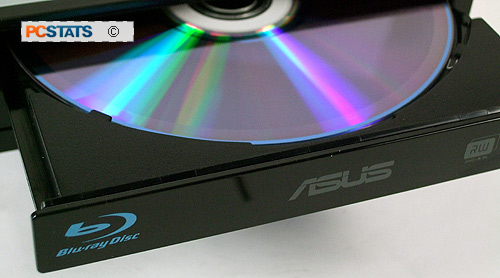 While pretty much everyone knows that Blu-ray is
the high-definition successor to DVD, the actual technical specifications for
this new optical technology get a little more complicated.
While pretty much everyone knows that Blu-ray is
the high-definition successor to DVD, the actual technical specifications for
this new optical technology get a little more complicated.
The 'blu' in Blu-ray refers to the blue wavelength of light emitted from
the laser used to read the Blu-ray discs. The shorter-wavelength light
(405nm to be specific) means more information can be packed into a the same
space because a finer stream of light is reading the data.
By comparison, red lasers operate around 650nm, so less data can be stored in
the same space.
Put another way, the capacity of Blu-Ray media is far greater than
what you'd get with DVD - up to 50GB of storage on a single disc, nearly six
times more information than a dual-layer 8.5GB DVD.
The other benefit to Blu-Ray is that the greater density of Blu-ray media
means faster reading and writing speeds. The default read rate for
Blu-ray media is 4.5 megabytes per second (also referred to as 1x
speed), so the 5x ROM speed of the ASUS BC-1205PT being reviewed
today is equivalent to 22.5 megabytes per second of bandwidth!
To convert all of that into actual video playback numbers, a regular Blu-ray
disc has enough bandwidth to play back 1920 x 1080 resolution at 24 frames
per second in progressive (rather than interlaced) mode, which is more
commonly known as the 1080p video standard. Standard 50GB dual-layer
Blu-ray media can have this information encoded in a variety of formats,
with the most efficient codecs capable of around four hours of video
playback at 1080p resolution.
Future Blu-ray media will expand beyond the 50GB storage limit by allowing
multiple layers of data to be added on to a single media disc, in much the same
way that dual-layer DVD media is created today. These multi-layer discs should
be backwards compatible with any Blu-ray player, and recently
introduced prototype 16-layer discs are capable of storing over 400GB of
data!
Prelude to Benchmarks
The details of how the ASUS BC-1205PT Blu-Ray dual layer SATA
DVD burner was configured for benchmarking, including the specific hardware,
software drivers, operating system and benchmark versions are indicated below.
The general specs for the reference platforms are the same. Please take a
moment to look over PCSTATS test system configurations before moving on to the
individual benchmark results.
 |
| PCSTATS Test System Specs: |
| processor: |
intel Core 2 Duo E6750 |
| Clock Speed: |
8 x 333 MHz = 2.66 GHz |
| Motherboards: |
MSI X48 Platinum |
| Videocard: |
MSI NX8800GTS-T2D320E
|
| Memory: |
2x 1024MB Corsair Twin2X2048-6400C4 |
| Hard Drive: |
74GB Western
Digital Raptor WD740 |
| CDROM: |
ASUS BC-PT1205-BD |
| Heatsink: |
Intel Reference Cooler |
| PowerSupply: |
PC Power & Cooling TurboCool 510 SLI |
| Software Setup |
Microsoft
Windows Vista Ultimate
Intel INF
9.0.0.1003
nVIDIA
Forceware 169.25 |
| Workstation Benchmarks |
SiSoft Sandra 2008
Nero CD
Speed | |
 SiSoft Sandra 2008
SiSoft Sandra 2008 |
Source: Sandra |
Sandra is designed to test the theoretical power of
a complete system as well as the individual components. The results are also
purely theoretical and may not represent real world performance.
|
Sisoft Sandra 2008 Benchmark Results |
|
Optical Drive |
ASUS
BC-1205PT |
| Disc Type |
BD-DVD |
| Rated Drive Speed: |
3.9x |
| Drive Index |
13.47 MB/s |
| Random Access: |
154ms |
| 1/3 Stroke Access: |
197ms |
| Full Stroke Access: |
325ms |
| Access Time: |
154ms |
SiSoft Sandra 2008 pegs the ASUS BC-1205PT as being a
little bit slower than its specified speed, which is typical for optical drives which list
their theoretical maximum read speeds instead of their averages. 13.47MB/s is still around 10MB/s faster than most DVD-ROMs can read data.
